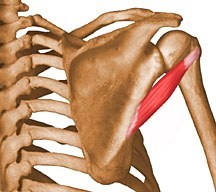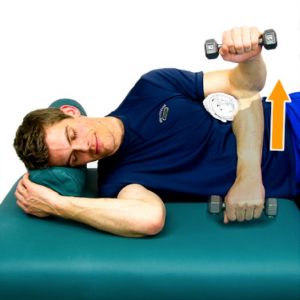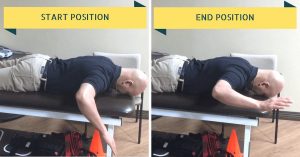

Therapist Blog by Jim Norris (PT, DPT)
The teres minor, along with the infraspinatus muscle, comprise the posterior rotator cuff of the shoulder. Both muscles play an important role in providing glenohumeral compression during upper extremity movements, which is needed for optimal shoulder function to occur. In addition to providing dynamic stability to the shoulder, these muscles also work with the posterior deltoid to externally rotate the shoulder. The infraspinatus provides a greater compression and external rotation force than the teres minor; however, it’s smaller role is still critical to proper functioning of the shoulder.1
The teres minor originates on the lower, lateral border of the scapula, and attaches to the humeral head on a bony landmark known as the greater tubercle. Unlike the infraspinatus, the amount of external rotation force the teres minor provides does not decrease as the shoulder is abducted (raised up overhead). This is important to enhancing joint stability by resisting superior humeral head translation (sliding up of the humeral head) and providing humeral head compression within the glenoid fossa of the scapula. In addition, the teres minor plays a very small role in shoulder adduction (bringing arm towards the body).2
How Is the Teres Minor Injured?
An injury to this muscle can be the result of trauma, such as a fall, direct blow to the shoulder, or rapid use of force (like pulling on a starter cable for a lawn mower). Injuries can also be the result of overuse (repetitive overhead reaching, pushing, or lifting with outstretched arms) or weakness of the muscle over a long period of time. Tendinitis, which is inflammation of the tendon, is a common pathology that results from overuse of the muscle. Tears of the tendon can also occur, which can happen due to a traumatic injury, such as a fall, or they can be degenerative which is a result of prolonged weakness. Degenerative tears are more likely to occur when the muscle is unused or maintained in a stretched position over a period of time (for example, sitting with rounded shoulders). Because the muscle also acts to stabilize and compress the humeral head in the glenoid fossa, weakness may also lead to secondary issues, including shoulder impingement.3, 4
How to Protect Yourself from Injury

The best way to protect yourself from any of these injuries starts with proper body mechanics and posture. In today’s society, a majority of us spend extended periods of time sitting due to our occupations.
Sitting makes it more difficult to maintain upright posture and to keep your shoulders from rounding forward. This leads to a prolonged stretch of the teres minor, that can also lead to weakness of the muscle. Poor posture can also be attributed to the fact that the vast majority of everyday motions occur in front of us (such as typing, writing, and reading). After establishing good postural awareness, strengthening the infraspinatus will further assist proper functioning of the shoulder by providing better dynamic stability.
Exercises to Prevent/ Rehabilitate

1. Side-lying ER
- To exercise the right side, begin by lying on the left, with the right shoulder pointing towards the ceiling
- Place a towel between the elbow and trunk and a pillow or cushion for head support.
- Maintain a retracted (squeeze shoulder blades together) position throughout the exercise.
- Keeping the elbow tucked bent to 90 degrees slowly rotate the weight away from the body but within a comfortable range
- Slowly return to the starting position
- Complete 2-3 sets of 10-15 repetitions.
2. Prone ER 90 degrees abduction

- Lay down face down on top of a table or bench with one shoulder at the edge.
- Keep the elbow bent at 90 degrees, and raise the arm so its inline with the shoulder using a light weight (1-2 pounds)
- Maintaining elbow flexion, slowly lower the arm and return it to the starting position, before rotating it towards the ceiling
- Complete 2-3 sets of 10-15 repetitions
3. Standing ER in the scapular plane (45 degrees abduction)
- In standing, start with the arm tucked in and elbow flexed to 90 degrees.
- Hold onto light resistance band or low weight with a cable column
- Band/weight should be set around waist height
- Maintaining elbow flexion, abduct the arm to 45 degrees, before bringing the elbow forward slightly into scaption plane (pictured above)
- Maintaining position of elbow and arm and externally rotate the shoulder
- Complete 2-3 sets of 10-15 repetitions
Finally, Thera-band (T-band) Rows are a great postural training exercise that can be done almost anywhere.
4. T-band Rows
- Wrap a band around a pole or any immovable object at belly button height.
- Hold on to both ends of the band so that there is equal length on each side, while also keeping tension in the band at the starting position
- Begin with elbows extended with an upright trunk (maintained throughout)
- Pull the elbows straight back, keeping them tucked in
- Retract shoulders while pulling band back (imagine trying to squeeze a dollar bill between each shoulder blade)
- Complete 2-3 sets of 10-15 repetitions
References
- Reinold MM, Escamilla R, Wilk KE. Current Concepts in the Scientific and Clinical Rationale Behind Exercises for Glenohumeral and Scapulothoracic Musculature. Journal of Orthopaedic & Sports Physical Therapy. 2009;39(2):105-117. doi:10.2519/jospt.2009.2835.
- http://www.exrx.net/Muscles/TeresMinor.html
- http://digitalrepository.unm.edu/cgi/viewcontent.cgi?article=1023&context=dpt
- https://www.uptodate.com/contents/rotator-cuff-tendinitis-and-tear-beyond-the-basics
Images
- https://18kxerroa80uqzne1b7qmoje-wpengine.netdna-ssl.com/wp-content/uploads/2015/11/teres-minor.jpg
- http://www.posturedirect.com/wp-content/uploads/2015/02/pelvposition1.png
- http://www.physicaltherapyfirst.com/files/shoulder-exercises/free-weight-external-rotation.png
- https://wizardofhealth.net/wp-content/uploads/2017/01/Prone-rotator-cuff-exercise.png
